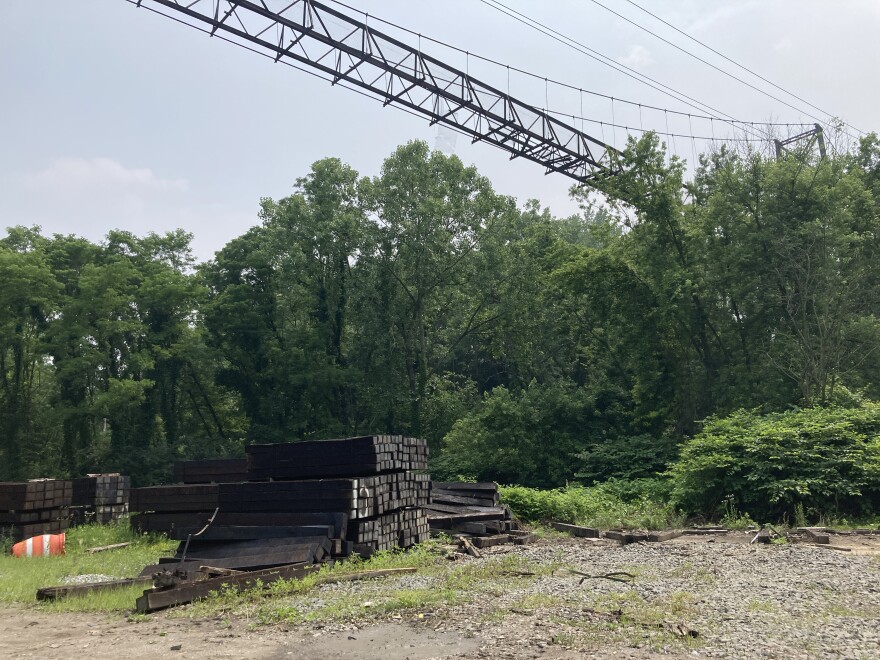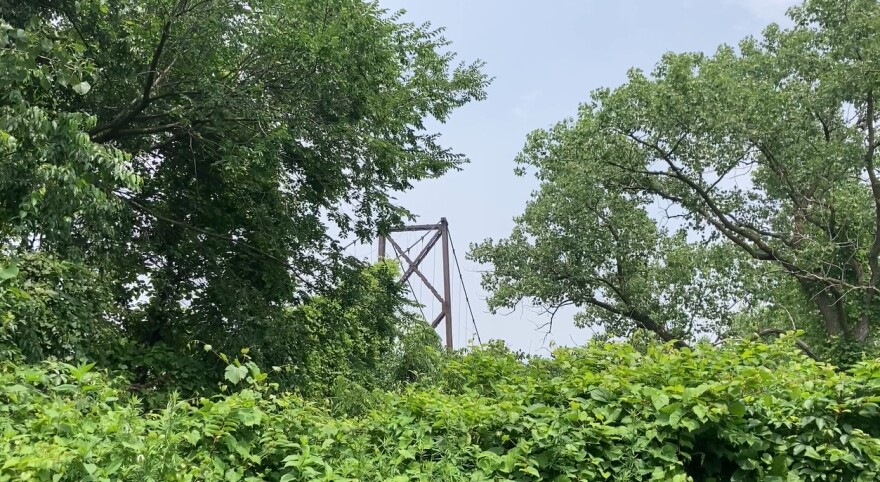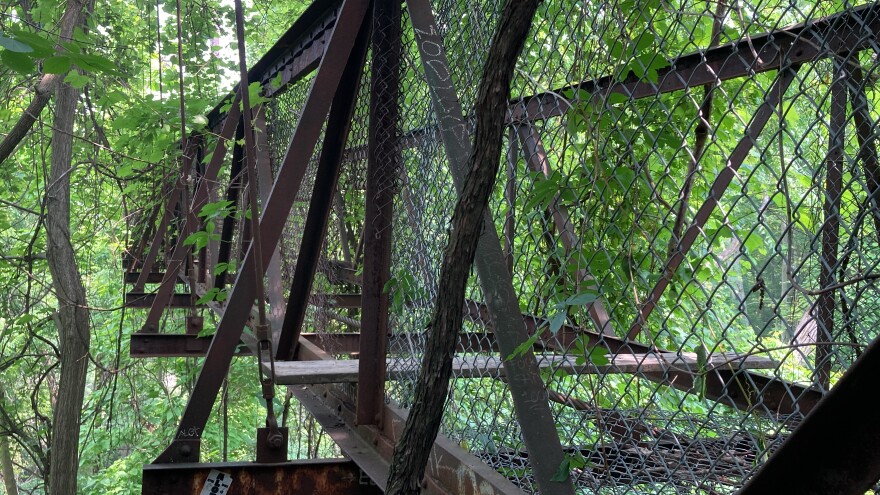Sidaway Bridge is Cleveland’s only suspension bridge, built nearly a century ago for pedestrians walking between the city’s Kinsman and Slavic Village neighborhoods. But since a period of racial unrest in the 1960s, the bridge has been quietly frozen in time.
A jungle forms a thick barrier between the naked eye and the steel structure, showing less rust than you’d expect for something which has been abandoned for 57 Cleveland winters. The distance to the ground below, where the Greater Cleveland Regional Transit Authority stores railroad ties and other equipment, can induce vertigo.

One end of Sidaway Bridge is in Slavic Village, near E. 65th Street and Sidaway Avenue, behind the carcass of the Dan-Dee Pretzel & Potato Chip Company. The brick-paved street is a dumping ground for old tires, broken bathroom fixtures and general food waste. This is no place for kids today, but dozens of them used to walk here daily, crossing the bridge to go to school, according to Case Western Reserve University history professor John Grabowski.
“On the one side of the bridge, which is now branded as Slavic Village, was a neighborhood known as Jackowa,” he said. “It was largely Polish. It was an industrial neighborhood. Across the ravine, you had the Kinsman neighborhood, which at one point was Jewish, Hungarian, also ethnic.”
How the bridge became a barrier
The demographics changed after World War II, as Cleveland’s Black population increased, de facto segregation decreased and many Black residents moved to places like Kinsman.
Regennia Williams, the Western Reserve Historical Society’s distinguished scholar of African American history and culture, grew up nearby.
“I remember when we moved to 78th Street, there were no Garden Valley housing projects,” she said. “We watched them demolish houses, and I just have these memories of white people running with furniture to trucks, just loading up everything. And the neighborhood flipped very quickly in the early 1960s.”
The bridge already had a troubled history, starting just after its completion in 1930. A believed serial killer, dubbed the torso murderer, left some of his victims in Kingsbury Run, below the bridge. Three decades later, the bridge itself would fall victim to racial tensions.
“You have an African American population across from the white ethnic population and the children go to… Tod Public School,” said Grabowski. “It's on the Jackowa side, and they come over the bridge. So, we have Black children coming through a mostly white community at that time.”
Williams went to school on the Kinsman side in the ‘60s, admiring the bridge from a safe distance.
“We were warned very early on in life that you don't go there,” she said. “‘Because of the white people who are on that end, who don't want you on that end of the bridge.’”
The issue was moot after racial tensions exploded during Cleveland’s deadly Hough riots in 1966.
“Somebody on the Slavic Village side decides that they want to close the bridge down,” Grabowski said. “They begin to pull up some of the boards which form the basis of the bridge, and they try to set fire to it. And so, the bridge is impassable.”
Suddenly, the bridge became a barrier. A five-minute walk turned into an hour journey. The city’s failure to repair and reopen Sidaway was cited a decade later, when a federal court ruled that Cleveland had unconstitutionally segregated its schools. A decade after the decision, the Dan-Dee chips operation had left town and Tod School had been demolished. The bridge’s metal structure became overgrown, and only in recent years is the bridge even fleetingly visible from a nearby highway.

A future for the bridge
Last fall, given its historic and architectural significance, the bridge was added to the National Register of Historic Places, followed by Cleveland Landmark status in February.
“We want to use the bridge as an attraction - a catalyst,” said Joy Johnson, executive director of nonprofit community developer Burten, Bell, Carr.
Her firm helped get the landmark status for Sidaway. The firm’s offices are a block from the Kinsman side of the bridge, and she said residents there feel disconnected from green space based on surveys her firm has conducted over the past seven years. Johnson added that the area’s public Metroparks system is mapped out along the same lines as the redlining maps of the early 20th century. She said she hopes to change that with development around the bridge, starting with some sort of arboretum or nature center.
“There’s so many natural species right there,” she said. “You would not think we have this kind of natural habitat just blocks away from busy thoroughfares.”
Johnson and her team are having discussions with the city, Greater Cleveland Regional Transit Authority and Western Reserve Land Conservancy to come up with a plan in the next 18 months. She said she wants to then start fundraising to attract state and federal grants. Getting the bridge itself restored is estimated to cost at least $9 million.

If the bridge were reopened, Cleveland Ward 5 Council Member Richard Starr said Sidaway would serve as an economic driver, noting the nearby Orlando Bread Company as one attractive employer.
“Being able to say, ‘I can walk to my job, within walking distance to my home,' but also having that lifestyle that I can live in my community," he said. "It’s very important for us to get that bridge back open, and I think it could really, really, really help our neighborhood.”
Dan Musson has been part of the city’s historic preservation team for 17 years and is currently secretary of the Landmarks Commission.
“With some structural analysis … I think it could be put back into use,” he said. “There's certainly a need for connecting neighborhoods. Times have changed so much since it was built.”
If Sidaway Bridge does reopen, Regennia Williams will be there.
“I’d walk across it – this time,” she said. “Please invite me when they restore the bridge.”



